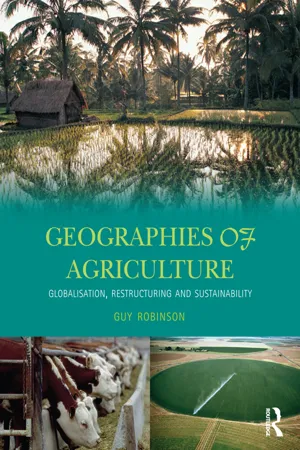Geography
Agricultural Production Regions
Agricultural production regions are geographic areas where specific crops or livestock are cultivated or raised. These regions are characterized by their suitability for certain types of agriculture due to factors such as climate, soil, and topography. They play a crucial role in global food production and trade, shaping the agricultural landscape and influencing economic and social dynamics.
Written by Perlego with AI-assistance
Related key terms
1 Key excerpts on "Agricultural Production Regions"
- eBook - ePub
Geographies of Agriculture
Globalisation, Restructuring and Sustainability
- Guy Robinson(Author)
- 2014(Publication Date)
- Routledge(Publisher)
2 The changing focus of agricultural geography2.1 ‘Traditional’ agricultural geographyThis chapter focuses on how the content of agricultural geography has evolved post-1945, thereby providing a context for the more extended consideration of key components of agricultural change in the rest of the book. Emphasis is placed upon how there has been a move from a ‘traditional’ form of agricultural geography to new approaches embracing different ideas from across the social sciences.A standard definition of agricultural geography in the mid-1980s referred to ‘the description and explanation of spatial variations in agricultural activity over the earth’s surface’ (Ilbery, 1985a, p. 1). This interpretation was based largely on consideration of two major avenues of enquiry that had dominated agricultural geography in the twentieth century:• Location and context, in which emphasis was placed on the regional characteristics of agricultural activities, especially broad trends and tendencies (Coppock, 1968; 1971).• Explanations of agriculture’s great diversity, through consideration of relationships between the large number of relevant variables associated with social, economic, physical and historical factors affecting agriculture (e.g. Grigg, 1992a).The regional focus in the first of these can be traced to the first time that a specialism specifically termed ‘agricultural geography’ played a leading role in the development of geography as an academic discipline. This was in the 1920s when agricultural geography was one of the principal specialisms that emerged as part of the growth of regional geography as the discipline’s central paradigm (Johnston, 1997, pp. 44–52). An example of this was Baker’s (1926) work on the recognition of ‘agricultural regions’ in different parts of the world. The region became the central focus of study for agricultural geographers, with both singleattribute and multi-attribute regions being recognised. Indeed, for the first half of the twentieth century agricultural geography involved regional delimitations following large-scale mapping of distributions of crops and livestock (e.g. Robertson, 1930) and the classification of agricultural systems (e.g. Whittlesey, 1936). Prevailing ideas on environmental determinisim emphasised the physical controls exerted upon the nature of agricultural activity. Description of agricultural variations was important, with land-use mapping of significance in some countries, a good example being the Land Utilisation Survey of Great Britain, begun in the 1930s by the geographer L. D. Stamp (1948).
Learn about this page
Index pages curate the most relevant extracts from our library of academic textbooks. They’ve been created using an in-house natural language model (NLM), each adding context and meaning to key research topics.
